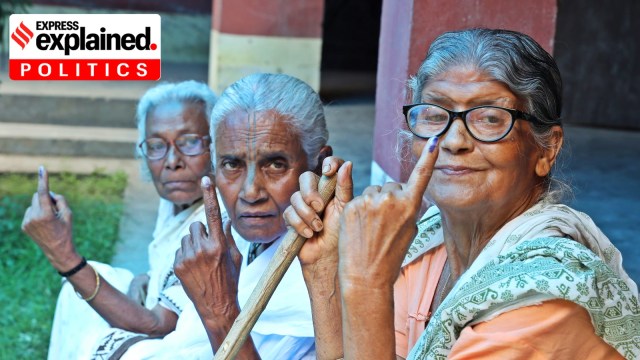- India
- International
The story of indelible ink, a lasting symbol of Indian elections, and who makes it
Devised as a method to prevent a person from casting more than one vote, the indelible ink has been used for decades in India. It has also travelled to other parts of the world for helping in conducting elections.
 Voters outside Choupathi High school, Vetaguri, Cooch Behar, West Bengal, after the first phase of voting for the 2024 Lok Sabha elections on April 19. (Express photo by Partha Paul)
Voters outside Choupathi High school, Vetaguri, Cooch Behar, West Bengal, after the first phase of voting for the 2024 Lok Sabha elections on April 19. (Express photo by Partha Paul)With the first phase of voting for the 2024 Lok Sabha elections beginning on April 19, the classic symbol of Indian polls is visible everywhere – a left hand with only its index finger extended, marked by a purple-black indelible ink.
Mysore Paints & Varnish Ltd., a Karnataka Government Undertaking which is the sole manufacturer of the ink in India, told DD News that around 26.5 lakh phials or small bottles (with a capacity of 10 ml each) will be made for this election cycle.
Devised to prevent a person from casting more than one vote, the ink has been used in Indian elections for long. The India-manufactured has also travelled to other parts of the world to be used in other elections.
Been in use for decades, with little change
Today, once a voter has her credentials checked at the polling booth, and before she casts her vote by pressing a button on the Electronic Voting Machine (EVM), the indelible ink is applied on her finger. This has been the case for decades, although the mode of voting has changed.
The Representation of the People Act (RoPA) of 1951 mentions the ink. Section 61 states that rules may be made under the Act “for the marking with indelible ink of the thumb or any other finger of every elector who applies for a ballot paper or ballot papers for the purpose of voting at a polling station before delivery of such paper or papers to him.”

Why papers? Because before EVMs, ballot papers existed at polling stations. They contained the list of contesting candidates alongside their party symbols and names. Voters had to mark their preference on the paper and then drop it in ballot boxes to vote.
Before being given the ballot paper, a voter’s index finger would be marked with the ink. The RoPA also speaks of rules being enacted “for prohibiting the delivery of any ballot paper” if a person already has a mark “on his thumb or any other finger…”
A report of the Election Commission of India (ECI) on the very first general elections (1951-52) said the ink was then applied with a glass rod. “That the ink proved quite satisfactory is evidenced by the fact that it is being used at many Local Bodies’ elections as well,” it said. In total, 3,89,816 bottles of indelible ink were supplied in the first elections to the states for Rs. 2,27,460.
Until the third general elections in 1962, the mark was made on the base of the forefinger, following which it was made just above the root of the nail on the skin, the ECI report said.
What makes the ink indelible?
Indelible ink contains silver nitrate. It is a colourless compound which becomes visible when exposed to ultraviolet light, including sunlight.
The higher silver nitrate’s concentration, say around 20 percent, the higher will be the ink’s quality, according to a report from the United Nations Development Programme. For up to 72 hours after application it can remain resistant to soap, liquids, home-cleansing, detergents, etc.
According to the government’s MyGov website, “This water-based ink also contains a solvent like alcohol to allow its faster drying… The precise protocol for making this ink including its chemical composition and the quantity of each constituent is, however, not known to many people.”
Who makes the indelible ink for Indian elections?
The indelible ink was first manufactured at the ECI’s request by the government’s Council of Scientific & Industrial Research (CSIR).
The MyGov website says, “It was to counter the challenge of fraudulent voting” that research work on formulating the ink began in the 1950s by scientists in the erstwhile Chemical Division. It was later patented by the National Research Development Corporation (NRDC), New Delhi.
Mysore Paints & Varnish Ltd. has been licensed to manufacture the ink and has been in the business since 1962. Earlier called Mysore Lac & Paint Works Ltd, it was established in 1937 by Nalwadi Krishnaraja Wodeyar, then the Maharaja of Mysore.
Currently, each phial is sold at a fixed rate of Rs 174. The website adds that the indelible ink is “exported to more than 25 countries that include Canada, Ghana, Nigeria, Mongolia, Malaysia, Nepal, South Africa and the Maldives.”
However, the procedure of application can differ in each election. “For example, in Cambodia and the Maldives, voters need to dip his/her finger into the ink while in Burkina Faso the ink is applied with a brush, and nozzles are used for its use in Turkey,” it says.
More Explained
EXPRESS OPINION
May 25: Latest News
- 01
- 02
- 03
- 04
- 05






























